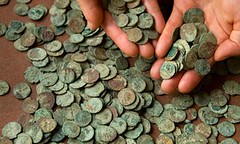
PREV ARTICLE
NEXT ARTICLE
FULL ISSUE
PREV FULL ISSUE
ARCHEOLOGISTS PONDER REASONS FOR FROME HOARD OF ROMAN COINS
The Guardian published an article this week examining possible reasons for the existence of the recently discovered Frome hoard. It's an interesting and lengthy article. Here are some excerpts. Thanks to The Explorator newsletter for the link.
-Editor
"I picked out a piece of Roman pottery, and when I turned it over there was a coin, a bronze radiate, stuck in it. When I turned over the next handful of clay, it was stuffed with coins — 20 at least. I just sat back on my heels and shouted: 'I've done it!'. I knew at once I'd found a Roman coin hoard in its undisturbed container — I knew the archaeologists would wet themselves." What he found that afternoon is now stacked in a waist-high pile of shoe box-sized cardboard boxes, in a corner of an office in the coins department of the British Museum – a Diagon Alley place of mysteries, on two floors, protected by a three-inch-thick strongroom door. The boxes hold the contents of a giant potbellied jar which lay in the clay of that sloping Somerset field for almost 2,000 years, filled to overflowing with the largest coin hoard ever found in a single container in Britain. "You can see what a job it's going to be to clean the horrors," Sam Moorhead, a Roman coins specialist, says fondly, running through his fingers a handful of disgusting bits of metal, green with corrosion, ragged with welded-on bits of other broken coins. Studying the 52,503 of them that are legible will occupy the experts for the rest of their careers. The conventional explanation is that these hoards are either underground piggy banks, or stashed in times of danger to be recovered when normal life resumes – or never, if the feared catastrophe overwhelms the owner. This fits some finds, such as the recent discovery in Somerset of English civil war-era silver, buried when the royalists were walled up in a nearby mansion with the parliamentarians on the march. But the Frome hoard doesn't match that picture at all. When Moorhead and Bland sorted the coins they could identify, they turned out to have been minted for 25 different emperors, but from oldest to newest, they spanned just four decades. So these were not the accumulated savings of generations of local people. The third century AD was not a time of trauma either. The Vikings were centuries away, the Irish behaving themselves, the Roman towns and cities growing a bit ragged at the edges, but the long rolling Somerset valleys were full of prosperous Roman villas and flourishing agricultural communities. Nor will the piggy bank explanation work. The pot could never have been carried to or from the site full – the thin pottery would have collapsed under the weight. Within a few months, as damp and dirt seeped into the jar, if the people wanted their money back, they would have had to do just what the archaeologists did: smash the container.
So what WAS the reason for the hoard? See the article to learn what the archeologists think.
-Editor
To read the complete article, see:
Why Frome is still cashing in on the Romans
(www.guardian.co.uk/science/2010/dec/12/ The Numismatic Bibliomania Society is a non-profit organization promoting numismatic literature. See our web site at coinbooks.org. To submit items for publication in The E-Sylum, write to the Editor at this address: whomren@gmail.com To subscribe go to: https://my.binhost.com/lists/listinfo/esylum All Rights Reserved. NBS Home Page Contact the NBS webmaster 
|
